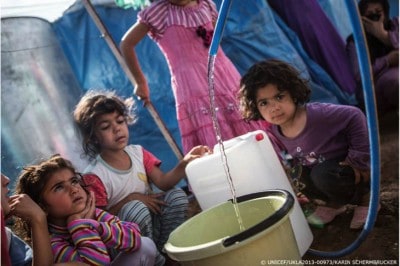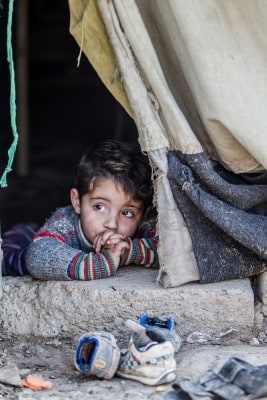
As the war in Syria enters into its sixth year, it’s estimated that one in three Syrian children have lived their whole lives under war and only know a life of despair and fear.
A Unicef report released last week found that 3.7 million children that were five or younger “has known nothing but a lifetime shaped by war.” Of these children, about 2.9 million are still living in Syria and 811,000 are living in neighboring countries as refugees.
Peter Salama, Unicef’s regional director for the Middle East and North Africa, said, “Five years into the war, millions of children have grown up too fast and way ahead of their time. As the war continues, children are fighting an adult war, they are continuing to drop out of school, and many are forced into labour, while girls are marrying early.” The impact this war could have on children is immeasurable, but the trauma from the constant fear, forced labor, childhood marriage, and a lack of education are guaranteed to harm these children for their entire lives.
On top of enduring these terrible conditions and not being able to live the normal life of a child within their country, “nearly seven million children live in poverty, making their childhood one of loss and deprivation.” Without basic needs and proper nutrition, the struggle of these children to survive normally paired with their exposure to war is heartbreaking.
The report went on to state that an estimated 200,000 children are living in areas of Syria that are currently under siege, and 2.1 million inside the country, along with 700,000 in neighboring countries, are out of school either because it is unsafe and they are hiding or because they are working.
Since a tentative ceasefire that began at the end of February, some children have been able to return to school in cities such as Aleppo and some citizens are trepidatiously engaging in normal activities again like attending weddings in the city of Deraa. The ceasefire was agreed upon as a precursor to the more formal peace talks in Geneva that are scheduled to take place. Children have emerged from underground classrooms and have begun attending school again and playing in the playgrounds for the first time in months. Sidra, one girl in Aleppo, said, “Thanks to the ceasefire, we can play and spend time with our friends. We can now play on the slides and swings.” This girl is grateful that a ceasefire, which most children around the globe have never even heard of, has allowed her to return to a normal life and simply wants to be a kid.

Although this ceasefire is a silver lining for many children wanting to return to school, not all children in Syria have been so lucky. According to the Unicef report, “Children report being actively encouraged to join the war by parties to the conflict offering gifts and ‘salaries’ of up to $400 a month.” For children living in extreme poverty and without proper information about what their role in the war would be, these offerings seem reasonable or, at the very least, their only hope for helping their family.
Unicef’s report stated that, “These children are receiving military training and participating in combat, or taking up life-threatening roles at the battle front.” Since children are more vulnerable and naive, they agree to roles in combat that they can’t even comprehend, and “parties to the conflict are using children to kill, including as executioners or snipers.” They went on to explain that the age for recruited children has decreased dramatically in the last two years, with the youngest Unicef-verified child being seven. Most of these children do not have parental consent, and now more than half of recruited children are under the age of 15.
The report gave a testimony from one of the girls that was recruited to fight in the war. “Huda was just 14 years old when she found herself in her first battle facing armed men, with a weapon she barely knew how to use,” the report said. Huda herself remembers that, “I was scared. The commander gave me a gun and said get ready for the battle.” Thankfully, Huda survived combat and now lives as a refugee in Jordan.
The terrorist group ISIS has increased its terrorization by releasing footage of child soldiers killing captives on the group’s command. Even if these children physically survive the war, they are likely to be severely affected by what this war has forced them to do for the rest of their lives.
Do you think that the United States and other nations could be doing more to help these children and families? Comment your thoughts below and share this article!
This article (3.7 Million Syrian Children Only Know A Life Filled With War) is free and open source. You have permission to republish this article under a Creative Commons license with attribution to the author and TrueActivist.com.


